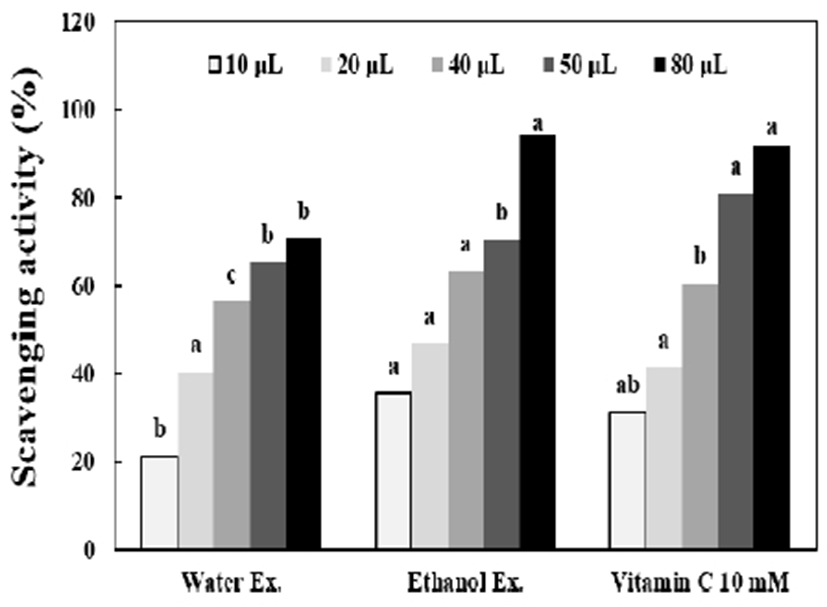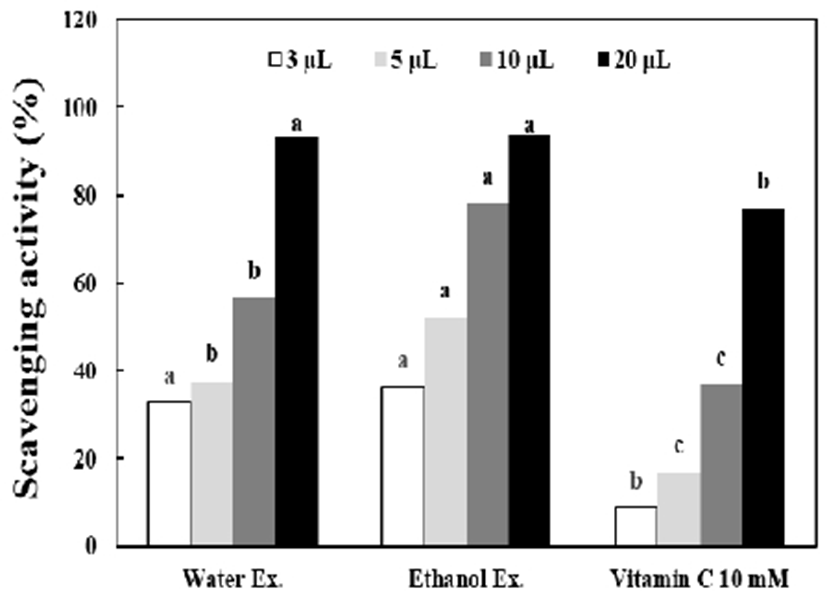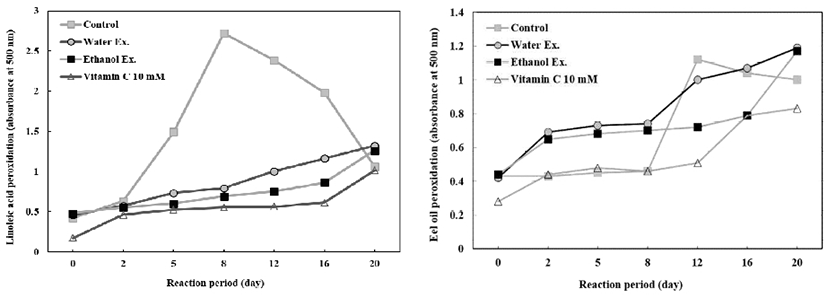Introduction
Fat and oil contained in food downgrade the food quality due to oxidation by oxygen, moisture, heat, and so on (1). The rise of heart related diseases sparked the interest in and consumption of diet, including fishes containing high unsaturated fat. However, fishes with high unsaturated fat have been difficult to process, store, and distribute because of its easy rancidity. In order to resolve the problem of easy rancidity, the researches on peroxide prevention have been undertaken in relation to various fishes, such as salted mackerel (2), anchovy oil (3), saury (4), seasoned squid (5), white fish meat (6) and shellfishes (7). Eel, one of Korean’s most favorite health foods in summer, also has high unsaturated fatty acid. Thanks to recent developments in farming skills, eel’s supplies increased, and their consumptions consequently increased (8,9); but there is few research on how to prevent eel’s peroxide for improving storage and distribution capabilities. Because green-tea has been reported in many literatures for its high antioxidant effects based on its polyphenol compound having antioxidant capacity (2,3,5,10,11). The aim of this research was to found out the antioxidant effects of green-tea extracts in regards to eel’s peroxide when they were pre-applied.
Materials and methods
Eels (Anguilla bicolor pacifica) used in the experiment were raised in the city of Naju, weighed 250-300 g, eviscerated, and cleaned before the use. Dried green-tea (Damian, Anyang, Korea) was used for extracting solutions to be pre-applied to eels for the purpose of preventing eel’s peroxide, easily accessible in the market. 50 g of green-tea was added to either distilled water or 2 L alcohol (30°), and then, it was extracted for 2 h at 112℃ using a pressured double boiler function in an electronic boiling pot (OC-2300R, OCOO, Co., Ltd., Boryeong, Korea). After the first try, the extracted solutions were poured out into different cups. Then, the second solutions were obtained through the same steps as in the first try. Once the first and the second solutions are ready, two were mixed, and filtered twice using gauze and paper filter (No.1, Whatman, Darmstadt, Germany), respectively. Water extract and ethanol extract were obtained using the same method. Soju was selected as an extracting solution for its easy application as a pre-treatment of eels in mass production settings. There were also researches reporting diluted ethanol solutions showed better antioxidant effects than ethier water or ethanol itself (12-14).
80 g of eel and 150 mL of extracted solution were put together in a clean vinyl bag, and laid for one hour in a tied-up bag. After 1 h, eel was taken out to get a clean-up shower. Once cleaned and dried up, eel was used for eel oil extraction.
Eel oil was extracted using the method specified by Folch et al. (15). 80 g of chopped eel was mixed with 300 mL of blended solution of chloroform and methanol (2:1, v/v), then they were extracted using a homogenizer (SMG-G, Shinsang, Co., Ltd., Seoul, Korea), and filtered using a paper filter (No.1). Another 250 mL of blended solution of chloroform and methanol was added to the residue, then they were extracted using a homogenizer, which constitute the second time of filtration. All obtained solutions were poured into a separatory funnel and mixed with distilled water, and laid for 15 to 20 h. After that, the layer of chloroform was separated, dehydrated by Na2SO4 and filtered (No.1). Eel oil was obtained by concentrating all filtered solutions under reduced pressure using a rotary evaporator (Rotavaor R-215, Büchi, Darmstadt, Germany) at 40℃.
DPPH radical scavenging effects were measured using extracted solution filtered via a paper filter (No.1) once. 1 mL of sample diluted by distilled water was mixed with 2 mL of ethanol and 0.5 mL of 700 μM 2,2-diphenyl-1-picrylhydrazyl (DPPH) solution (Sigma-Aldrich Co., St Louis, USA). DPPH radical scavenging effects were measured at 517 nm absorbance using UV-spectrophotometer (UV-1650, Shimadzu, Kyoto, Japan) (16).
After 7 mM ABTS (Sigma-Aldrich Co.) and 2.45 mM potasium persulfate (Sigma-Aldrich Co.) were mixed at the rate of 1:1, the solution was refrigerated for 18 h. Prior to the experiment, the solution was diluted so that it may have the absorbance of 1±0.1 at 734 nm. 0.3 mL of the extract was blended with 2.7 mL of diluted ABTS solution, and laid for 20 min at the room temperature. After 20 min of reaction time, the absorbance was measured at 734 nm (17). The relative free radical scavenging effects of extract in relation to DPPH and ABTS were calculated using the formula below.
After 1 to 2 g of lipid recovered using a method specified in Korean food code was taken into a flask, 25 mL mixed solution of acetic acid and chloroform (3:2, v/v) was added. On top of it, 1 mL of KI saturated solution was also added. Then, it was laid in the dark room for 10 min after being shaken for a min. With 30 mL of distilled water and starch indicator solution injected, the point without color was chosen as the end point through titration by 0.01 N Na2S2O3 (17,18)
After 1 to 2 g of eel oil using a method specified in Korean food code was taken into a flask, 100 mL mixed solution of methanol and ether (2:1) was added. With 1-2 drop of phenolphthalein indicator injected, the point with pink color was chosen as the end point through titration by 0.1 N KOH (19).
After placing 0.05 g of eel oil into 100 mL glass bottle with a cap, benzen 5 mL, 0.05% 2,4-dinitrophenyl hydrazine (DNPH) benzen 5 mL, and 4.3% trichloroacetic acid 3 mL were arranged to be injected into the bottle. Then, the mixture was warmed up in a double boiler of 60℃ water bath for 30 min. After cooling it off at room temperature and popping the color with 10 mL of 4% KOH-ethanol, the absorbance was measured at 440 nm (20).
After mixing and sonicating 200 mg of TBA with 100 mL of 95% butanol at 60℃ sonicator (Ultrasonic, JAC 4020, KODO, Whasung, Korea) for 30 min using a method specified in Korean food code (18), thiobarbituric acid (TBA) reagent was taken into a form with a direct mix of glacial acetic acid at the rate of 1:1. TBA value was obtained through the absorbance measurement at 530 nm after cooling off the solution, a blend of 0.05 g of eel oil, 10 mL benzen, and 10 mL of TBA reagent, which was kept for 2 h in 95℃ water bath, in the flowing water. TBA value was calculated using the formula below (18).
Once 0.2 mL of eel oil (or linoleic acid 0.13 mL), 10 mL of 100% ethanol, 50 mM of phosphate buffer solution (pH 7.4), and 1 mL of antioxidant extract were put together in a 50 mL conical tube, distilled water was added to make the final amount of solution 25 mL. Then, peroxide was induced through 20 days of reaction in 40℃ water bath. The peroxide value was measured, using thiocyanate method, at 500 nm absorbance after placing for 3 min the mixture of 0.1 mL reactant, 4.7 mL of 70% ethanol, 0.1 mL of 30% NH4SCN, and 0.1 mL of 0.02 M FeCl2 in 3.5% hydrochloric acid.
Results and discussion
In order to compare the DPPH and ABTS scavenging effects between water and ethanol extract of green-tea, Vitamin C 10 mM solution was used as a positive control. The correlation coefficient between concentration and absorbance was more than 0.9 (r>0.9). Green-tea extracts were effective in DPPH radical scavenging, depending on the volume of extracts. Ethanol extract of green-tea had not only higher effects than water extract, but also as high scavenging effects as Vitamin C 10 mM had. The findings were supported by Son et al. (11) who addressed the higher DPPH scavenging effects of methanol extract of green-tea than water extract, and by Shon et al. (14) who reported ethanol extract of Doraji (Platycodon grandiflorum) had higher scavenging effects than methanol extract and water.
The scavenging effects of green-tea extracts on ABTS solution producing peroxide radicals were found to be in accordance with the volume of extracts as it was with DPPH radical scavenging effects. Both water and ethanol extracts of green-tea had higher scavenging effects than vitamin C 10 mM solution, and ethanol extract of green-tea was more effective than water extract (p<0.05). The findings that green-tea extracts were not so much effective as vitamin C in DPPH radical scavenging, but were more effective than vitamin C in ABTS radical were in accordance with the previous researches, and the difference is believed to come from the different antioxidant materials in each extract (17,21).


In measuring lipid rancidity, acid value identified by free fatty acid analysis was used (1). While the acid vale of mackerel pre-treated with green-tea extract and also widely known for ease of lipid rancidity due to high unsaturated fatty acid was 2.3 mg KOH/g in pre-refrigeration stage (2), and commercial semi-dried conger eel’s acid value was 8.5 mg KOH/g on average (22), the pre-refrigeration acid value of eel in this research was 2.7 mg KOH/g.
After 21 days of refrigeration, the acid value of the control was 4.4 mg KOH/g, which was 62.9% increase from the start. And the acid value of water extract treated and ethanol extracted ones were respectively 3.1 mg KOH/g and 3.6 mg KOH/g, which were also respectively 15.7% and 36.5% increase from the start. The acid value of positive control, which was eels treated with vitamin C, was 2.9 mg KOH/g, and it was 10.5% increase from the start. Those treated with green-tea extract and vitamin C maintained the acid value similar to that of the zeroth day of refrigeration until the 21st day of refrigeration (p<0.05). Overall, water extract treated one yielded lower acid value than ethanol extract, and water extract of green-tea showed similar effects as vitamin C 10 mM solution did (p<0.05).
On the zeroth day of refrigeration, the peroxide value of eel for the control, the one treated with green-tea extracts and the one treated with vitamin C, were 7.4, 7.2, and 7.4 meq/kg, respectively; the difference was nominal. The peroxide value of the control increased to 13.9 meq/kg, which accounted for 88.9% increase, on the 7th day of refrigeration while it rose to 15.5 meq/kg, an 109.4% increase, on the 21st day of refrigeration. The peroxide value of the eels treated with vitamin C 10 mM solution increased to 9.7 meq/kg on the 7th day of refrigeration, and to 11.3 meq/kg on the 21st day of refrigeration. which accounted for 32.0%, and 54.2% increase, respectively. The peroxide value of the eels treated with green-tea water extract and ethanol extract were 9.9 and 9.2 meq/kg, respectively, on the 7th day of refrigeration, and 11.7 and 11.9 meq/kg, respectively, on the 21st day of refrigeration. which showed similar level of peroxide prevention effect as found in vitamin C solution (p<0.05). Previously, the researchers found out water extract of green-tea prevented the peroxide of anchovy oil (3) and green-tea was used to improve the quality of sea-products in process (5,23).
Carbonyl compound, which can be generated by proteolysis and amino acid oxidation, can produce toxic substance from the reaction to fatty acid compound, such as malondialdehyde, and 4-hydroxynonenal (24). Those treated with green-tea water extract maintained the carbonyl value similar to that of the zeroth day of refrigeration until the 21st day of refrigeration (p<0.05). The carbonyl values of untreated eel were 2.1 meq/kg on the zeroth day, 2.5 meq/kg on the 7th day, and 2.9 meq/kg on the 21st day; in short, there was 40 percent increase in carbonyl compound by the end of 21 days of refrigeration.
However, the carbonyl values of eel treated with green-tea extracts were increased by just 6 to 9 percent by the end of 21 days of refrigeration, which indicated green-tea extracts actually prevented the generation of carbonyl compound, a lipid oxidation product (p<0.05). Compared to the control, the peroxidation value of those treated with green-tea extract and vitamin C did not increase much; therefore, it was believed those treatments were stable against the oxidation until the 7th day of refrigeration (p<0.05). In the case of eel treated with vitamin C 10 mM solution, the carbonyl value were 2.2 meq/kg on the 7th day, and 2.6 meq/kg on the 21st day. As carbonyl value of eel treated with vitamin C 10 mM solution was increased by 27 percent by the end of 21st days of refrigeration, although it previously yielded the similar effects in terms of acid values and peroxide values, vitamin C 10 mM solution was not so effective as green-tea extracts in preventing the generation of carbonyl compound (p<0.05). The generation of carbonyl compound in meat exploded when proteolysis activities increased (17). Considering the fact that carbonyl value of eel stored at 37℃ for one week was 9.14 meq/kg (20), the carbonyl compound generation speed of vacuum-packed and refrigerated eel was quite hindered.

TBA value is a degree of oxidative rancidity in fats, which measures color of a product, a reaction between thiobarbituric acid and malondialdehyde formed by oxidation of polyunsaturated fatty acids (17). TBA values of untreated eel were 2.11 on the zeroth day, and 3.6 on the 7th day, which was higher than the rest samples. TBA values got lower in the order of ethanol extract, water extract, and vitamin C solution. Even though TBA value of untreated eel was 7.5 on the 21st day, a 256 percent increase, TBA values of green-tea extract treated and vitamin C treated eels were 4.6 and 5.6, respectively, which also were 118% and 164% respective increase compared to the values on the zeroth day. There was no meaningful difference, but the TBA value of green-tea extracts were lower than vitamin C solution; therefore, green-tea extracts were determined to prevent oxidative rancidity (p<0.05).
For the purpose of measuring the peroxide prevention effects of green-tea extracts, they were added to linoleic acid or eel oil extract, and induced oxidative reaction at 40℃ for a certain period of time. The peroxide of linoleic acid began to increase sharply on the 5th reaction day and produced the largest amount from the 8th thru 12th reaction day. Based on the fact, peroxide induction period of linoleic acid was determined to fall between 5 to 8 days. After the 12th reaction day, the degree of peroxide began to decrease due to peroxide's the decomposition into the secondary oxidation products through its continual autoxidation (1). In the case of Vitamin C 10 mM solution, a well-known antioxidant, the oxidation of linoleic acid was gradual up to the 20th reaction day. Regarding water extract of green-tea, peroxide induction period in which peroxide products began to increase sharply was on the 12th reaction day. As for ethanol extract of green-tea, peroxide induction period was on the 20th reaction day, just like vitamin C. In short, green-tea extracts were effective in preventing peroxide of linoleic acid, and ethanol extract was more effective than water extract. In peroxide induced reaction of eel oil, peroxide reaction sharply increased on the 12th reaction day in the control. In regards to vitamin C 10 mM solution, peroxide reaction was gradually increased, and sharply rose on the 16th reaction day. Water extract of green-tea, like the control, yielded a high volume of peroxide product on the 12th reaction day while ethanol extract produced a sharp increase of peroxide on the 20th reaction day. Based on the peroxide induced reaction of eel oil, ethanol extract of green-tea delayed peroxide induction period of eel oil. Green-tea was reported to prevent peroxide of anchovy oil, salted mackerel, and seasoned squid (2,3,5). After the pre-application of water and ethanol extracts of green-tea to eels, acid values, peroxide values, carbonyl values, and TBA values were lower than the untreated eels; therefore, they were determined to be effective in preventing peroxide. Especially, ethanol extract showed similar antioxidant effects to vitamin C 10 mM. In conclusion, eels treated by green-tea extracts and packed in vacuum are believed to be similar to fresh eels for seven days in the refrigerator and possible to be refrigerated up to 21 days.










